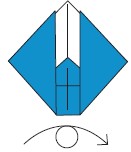Michael G. LaFosse - Origami Bugs: This Easy Origami Book Contains 20 Fun Projects, Origami How-To Instructions and Downloadable Content: Great for Kids and Parents
Here you can read online Michael G. LaFosse - Origami Bugs: This Easy Origami Book Contains 20 Fun Projects, Origami How-To Instructions and Downloadable Content: Great for Kids and Parents full text of the book (entire story) in english for free. Download pdf and epub, get meaning, cover and reviews about this ebook. year: 2014, publisher: Tuttle Publishing, genre: Children. Description of the work, (preface) as well as reviews are available. Best literature library LitArk.com created for fans of good reading and offers a wide selection of genres:
Romance novel
Science fiction
Adventure
Detective
Science
History
Home and family
Prose
Art
Politics
Computer
Non-fiction
Religion
Business
Children
Humor
Choose a favorite category and find really read worthwhile books. Enjoy immersion in the world of imagination, feel the emotions of the characters or learn something new for yourself, make an fascinating discovery.
- Book:Origami Bugs: This Easy Origami Book Contains 20 Fun Projects, Origami How-To Instructions and Downloadable Content: Great for Kids and Parents
- Author:
- Publisher:Tuttle Publishing
- Genre:
- Year:2014
- Rating:5 / 5
- Favourites:Add to favourites
- Your mark:
Origami Bugs: This Easy Origami Book Contains 20 Fun Projects, Origami How-To Instructions and Downloadable Content: Great for Kids and Parents: summary, description and annotation
We offer to read an annotation, description, summary or preface (depends on what the author of the book "Origami Bugs: This Easy Origami Book Contains 20 Fun Projects, Origami How-To Instructions and Downloadable Content: Great for Kids and Parents" wrote himself). If you haven't found the necessary information about the book — write in the comments, we will try to find it.
Make simple and fun origami insects with this easy paper craft ebook.
Ants, dragonflies, tarantulas are just a few of the creepy, crawly creatures you can create with this friendly origami ebook. World renowned origami artist Michael LaFosse introduces this paper craft ebook that kids and paper folders of all ages will loveturning brightly colored sheets of origami paper into 20 different insects and arachnids. Use it to craft eye-catching origami for your friends, to decorate your roomor as a wonderful gift for insects lovers.
All of the folds are simple enough to be origami-for-kids projects and are a great way to learn origami.
This origami ebook contains:
Origami projects include:
Michael G. LaFosse: author's other books
Who wrote Origami Bugs: This Easy Origami Book Contains 20 Fun Projects, Origami How-To Instructions and Downloadable Content: Great for Kids and Parents? Find out the surname, the name of the author of the book and a list of all author's works by series.

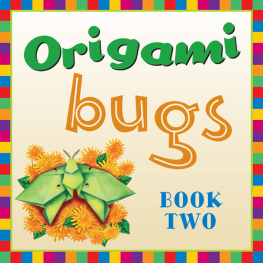
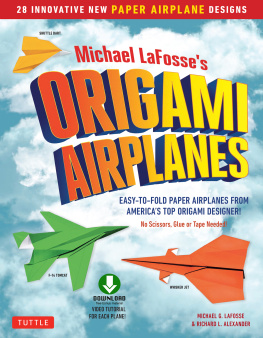
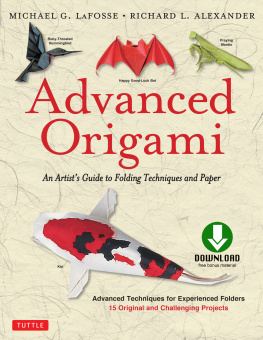
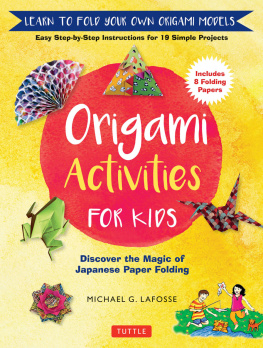
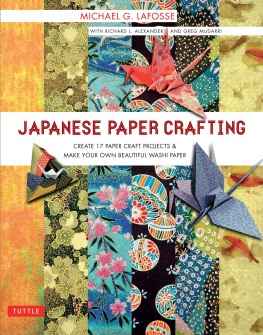

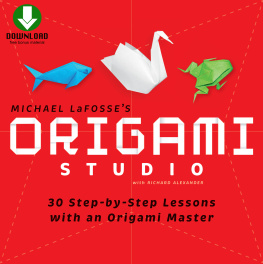
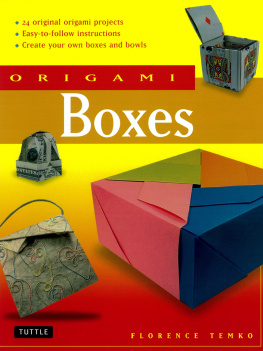
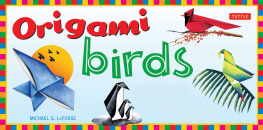
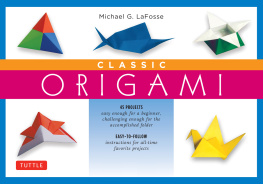
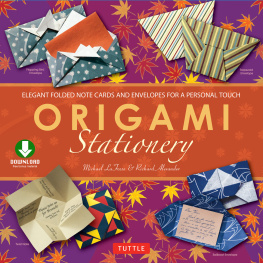
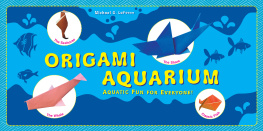
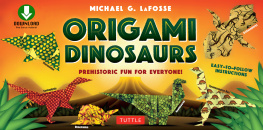
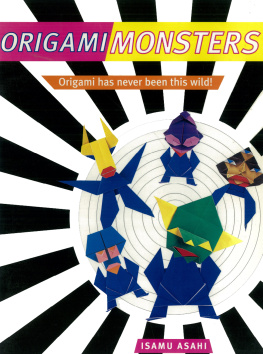
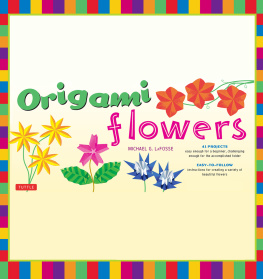

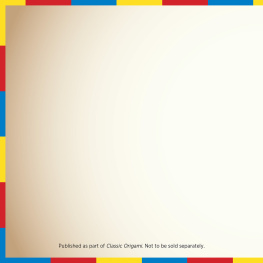
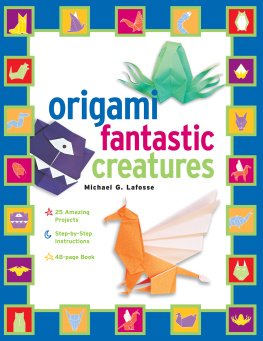
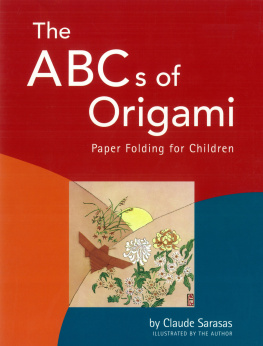
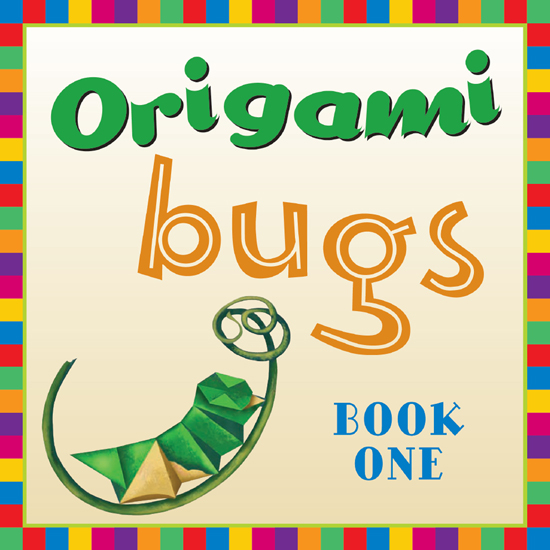


 Designed by Michael G. LaFosse
Designed by Michael G. LaFosse  Pre-crease your paper as shown: First fold in half and unfold. Then, fold in the sides. You may experiment with different distances for the sides to be away from the center crease.
Pre-crease your paper as shown: First fold in half and unfold. Then, fold in the sides. You may experiment with different distances for the sides to be away from the center crease. 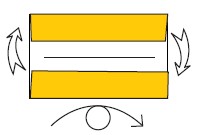 Turn the paper over.
Turn the paper over. 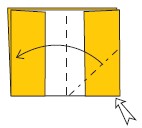 Move the top layer of the right half over to the left and flatten the paper.
Move the top layer of the right half over to the left and flatten the paper. 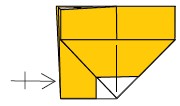 Squash-fold the other side to match.
Squash-fold the other side to match. 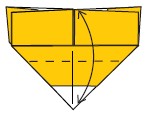 Fold up the bottom corner to the middle of the top edge and bring it back down.
Fold up the bottom corner to the middle of the top edge and bring it back down.  One at a time, squash-fold the left and right halves of the paper.
One at a time, squash-fold the left and right halves of the paper. 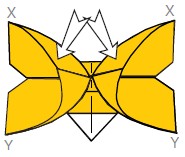 Squash fold in progress.
Squash fold in progress. 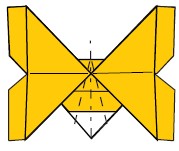 Mountain- and valley-fold the middle to form a body.
Mountain- and valley-fold the middle to form a body. 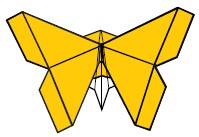 The finished Butterfly.
The finished Butterfly. Designed by Michael G.
Designed by Michael G.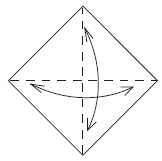 Valley-fold, corner to corner both ways.
Valley-fold, corner to corner both ways. 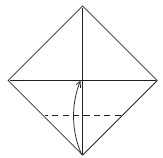 Fold the bottom corner up to the center of the paper where the creases cross.
Fold the bottom corner up to the center of the paper where the creases cross. 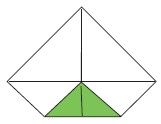 Turn the paper over, top to bottom.
Turn the paper over, top to bottom. 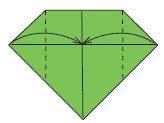 Fold in the left and right corners to meet at the center.
Fold in the left and right corners to meet at the center. 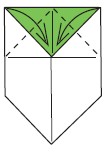 Fold top two corners down to the colored point.
Fold top two corners down to the colored point. 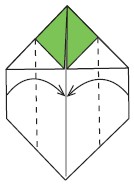 Fold in the left and right edges to meet in the middle.
Fold in the left and right edges to meet in the middle. 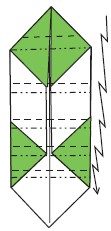 Mountain- and valley-fold a series of parallel pleats to make overlapping segments.
Mountain- and valley-fold a series of parallel pleats to make overlapping segments. 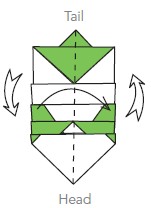 Fold in half.
Fold in half. 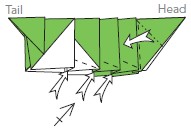 Push in the inside corners of the body segments. Repeat on the other side. Squash-fold the head corner to the left, over the front end of the body.
Push in the inside corners of the body segments. Repeat on the other side. Squash-fold the head corner to the left, over the front end of the body. 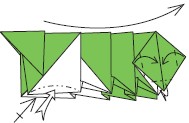 Fold the left and right corners of the head into the center. Mountain-fold the bottom corner of the head to hide it.
Fold the left and right corners of the head into the center. Mountain-fold the bottom corner of the head to hide it.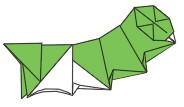 The finished Caterpillar.
The finished Caterpillar. Designed by Michael G. LaFosse Use a 6-inch (15 cm), square origami paper, white on one side, color on the other.
Designed by Michael G. LaFosse Use a 6-inch (15 cm), square origami paper, white on one side, color on the other. 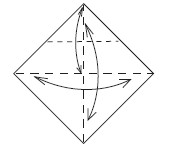 Begin white side up, if you are using paper that is printed on only one side.
Begin white side up, if you are using paper that is printed on only one side. 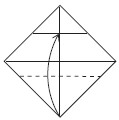 Fold the bottom corner up to the topmost crossing of creases.
Fold the bottom corner up to the topmost crossing of creases.  Fold up the bottom edge using the existing horizontal crease.
Fold up the bottom edge using the existing horizontal crease.  Fold up the left and right corners. Align the edges to the top corner but leave a gap, showing the white paper for the abdomen.
Fold up the left and right corners. Align the edges to the top corner but leave a gap, showing the white paper for the abdomen.